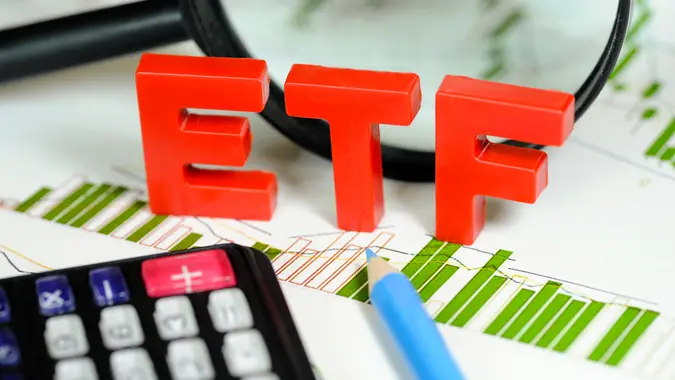Best Places To Save Money Safely and Earn a Return

Commitment to Our Readers
GOBankingRates' editorial team is committed to bringing you unbiased reviews and information. We use data-driven methodologies to evaluate financial products and services - our reviews and ratings are not influenced by advertisers. You can read more about our editorial guidelines and our products and services review methodology.

20 Years
Helping You Live Richer

Reviewed
by Experts

Trusted by
Millions of Readers
In today’s uncertain economy, finding the best place to save money is more important than ever. Whether you’re saving for a short-term goal or protecting your emergency fund, these options offer safety and steady growth.
Short-Term, Low-Risk Savings
Here are the best options if you want safe assets that provide a good level of liquidity over the short term:
- High-Yield Savings Account
- Certificates of Deposit
- Money Market Accounts
High-Yield Savings Account
A high-yield savings account is an ideal option if you’re looking for immediate liquidity, a high APY and an insured investment. While traditional banks still mostly pay very low yields, online savings accounts have no fees and pay 10x as much interest, or even more. Yet they remain insured by the FDIC up to $250,000, and you can typically access your funds at any time via an ATM/debit card.
Certificates of Deposit
Certificates of deposit are another type of safe investment favored by conservative investors. CDs are issued by banks and generally come with fixed interest rates and maturity dates, although in some cases, those may be flexible. Certificates of deposit carry the same FDIC insurance as savings accounts.
CDs often pay interest rates slightly above savings rates, but they come with the caveat that if you withdraw your money before they mature, you may get hit with an early withdrawal penalty.
Money Market Accounts
Money market accounts aren’t quite as common as they used to be, but many banks still offer them. One of the main appeals of a money market account is that it’s something of a hybrid, combining the best features of a savings account and a checking account. Most money market accounts pay yields that equal or exceed those of a savings account, but they also offer check-writing capabilities.
On top of that, money market accounts are also FDIC-insured, the same as savings accounts and CDs.
Low-to-Moderate Risk, Income-Producing Assets
If you’re willing to tie up your money a bit longer, you can generally earn a higher return. In many cases, you won’t even have to take on additional risk of capital loss — but you may have to take on other risks, such as inflation risk, duration risk or interest-rate risk.
- Insured Municipal Bonds
- U.S. Treasury Securities
- Dividend Aristocrats
Insured Municipal Bonds
Municipal bonds are issued by cities, states, and localities, typically to raise money for public works like infrastructure or schools. Most municipal bonds are assigned ratings by third-party, independent agencies like corporate bonds.
However, unlike corporate bonds, many municipal bonds are also insured. This means that in the typically unlikely event that a municipal bond were to default, an independent insurance agency would pay off the bond and make investors whole. In terms of safety, insured municipal bonds are just a step below U.S. Government securities.
U.S. Treasury Securities
U.S. Government securities are backed by the “full faith and credit of the United States government.” Essentially, this means that the government will never default on interest or principal payments of these securities. As the government has cash reserves, taxing authority and the ability to issue new debt to pay off old debt continually, U.S. government securities are considered the safest in the world.
As an added benefit, U.S. Treasury securities are exempt from state and local taxes.
Dividend Aristocrats
If you’re willing to take the risk of owning individual stocks, starting with dividend aristocrats is a good option. Dividend aristocrats are companies that have not only paid but also raised their dividends for at least 25 consecutive years. This is only possible if a company has a relatively mature business with a consistent cash flow, meaning dividend aristocrats generally represent the most famous companies in the world.
Although all stocks can be volatile, dividend aristocrats are generally more stable than the broader market. Customers tend to buy their well-known, name-brand products during any economic environment. The income component of their return–which, by definition, rises every year–provides a cushion for investors looking for a safe harbor investment.
Longer-Term, Higher Risk/Higher Return Potential
Higher risk typically comes with higher rewards. These longer-term investments aren’t appropriate if you’re looking for liquidity or preservation of capital. However, over the longer term, your potential for gain is much higher.
- Workplace Retirement Plan
- Real Estate
Workplace Retirement Plan
If you’re looking for a place to stash your money for the long run, your workplace retirement plan is one of the best options.
When you contribute to a retirement plan like a 401(k), not only do you get to contribute pre-tax money, your assets grow tax-deferred until you withdraw them. And with a 10% early withdrawal penalty applying until you reach age 59 ½, you’ll be more inclined to keep your money invested, which is one of the keys to long-term investment success. In most cases, your employer will match a portion of your contributions, which essentially amounts to free money for your retirement.
Within the confines of a 401(k) plan, you can usually choose conservative investment options like short-term government bonds, if you would like. However, the best use of a 401(k) is generally for long-term growth, so you should speak with your financial advisor to make sure you are maximizing your retirement investments.
Real Estate
Real estate is one of the most illiquid investments, and that’s important to understand before you stash your money there. It can take months or even years to sell a property, so you should never invest money you need in the short term in real estate.
However, unlike many other investments, real estate is a tangible asset. Unlike stocks or even government bonds, real estate is something you can touch and see. Combined with the inherent need of people to have someplace to live, real estate — when located in an attractive area — can offer good long-term value.
However, real estate is riskier than many of the other options on this list due to its illiquidity, the long-term holding periods usually required, and the lack of insurance or guarantees.
Consider real estate investment trusts, or REITs, if you want exposure to real estate income without directly owning property. These offer dividends and are more liquid than physical real estate.
Comparison of Savings Options
No single savings option is right for every person at every time. All high-quality savings options have pros and cons. Here’s a look at how various assets compare side-by-side.
| Option | Risk Level | Liquidity | Return Potential |
| High-Yield Savings | Very Low | High | Low to Moderate |
| CD | Very Low | Low | Moderate |
| Treasury Bonds | Very Low | Medium | Moderate |
| Dividend Stocks | Moderate | High | Moderate to High |
| Real Estate | High | Low | High (Long-Term) |
Which Place Is Right for Your Money?
Now that you’ve learned the characteristics of various assets, including their risk-reward profiles and their pros and cons, which place is right for your money? The answer depends on your financial objectives, risk tolerance, and investment timeline.
- Need quick access and safety? Use a high-yield savings or money market account.
- Saving for a 1-3 year goal? Consider a CD or Treasury bill.
- Want a higher income over time? Look into dividend stocks or municipal bonds.
- Long-term growth? Max out your 401(k) or consider real estate.
Always consider your investments in terms of your overall portfolio. If you’re 30 years old, for example, you certainly need an emergency fund, but you’ll also need to plan for your long-term future. In that scenario, putting all of your money into a short-term option, no matter how secure, won’t meet all of your needs.
Investments inherently carry risk, which is a tradeoff for the potential reward they offer. But risk is not spread equally across different investments. Where is the best place to hold money? For those who are particularly risk-averse, investments that have insurance or government guarantees, like CDs, insured municipal bonds, savings accounts, and U.S. Treasuries, are a good bet.
But for those willing to trade off some safety in exchange for the potential of higher return, investments like high-dividend stocks, 401(k) plans, or even real estate may hold more interest. But before you take the plunge, be sure to consult with a financial advisor to chart out exactly where you stand on the risk/reward spectrum so you can devise an appropriate portfolio strategy.
Our in-house research team and on-site financial experts work together to create content that’s accurate, impartial, and up to date. We fact-check every single statistic, quote and fact using trusted primary resources to make sure the information we provide is correct. You can learn more about GOBankingRates’ processes and standards in our editorial policy.
- TurboTax. 2022. "Guide to Investment Bonds and Taxes."
- Charles Schwab. 2023. "Choosing Municipal Bonds: GO or Revenue?"
 Written by
Written by  Edited by
Edited by 

























